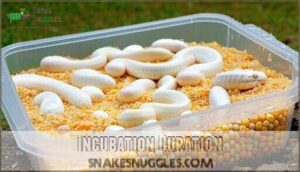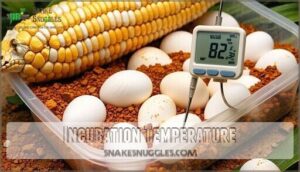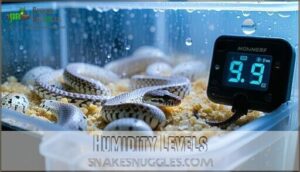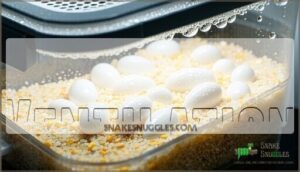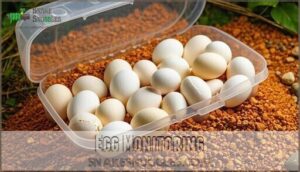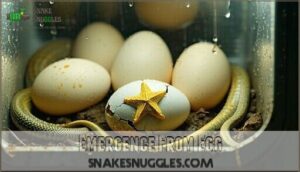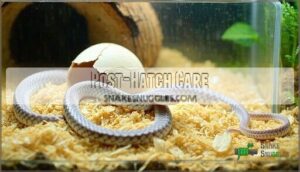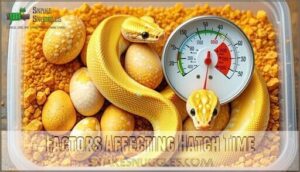This site is supported by our readers. We may earn a commission, at no cost to you, if you purchase through links.
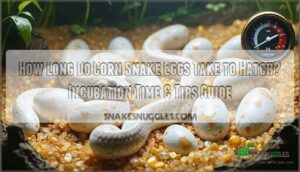
Your eggs need 80-90% humidity and good ventilation to prevent mold growth. Watch for pipping – tiny cracks that signal hatching has begun. The process takes about 24 hours once it starts, with hatchlings using their egg tooth to slice through the shell.
Temperature consistency makes all the difference between success and disappointment.
Table Of Contents
- Key Takeaways
- How Long Do Corn Snake Eggs Take to Hatch?
- Incubation Duration
- Incubation Temperature
- Incubation Environment
- Egg Monitoring
- Hatching Process
- Factors Affecting Hatch Time
- Troubleshooting Hatching Issues
- Frequently Asked Questions (FAQs)
- What temperature to incubate corn snake eggs?
- How many eggs do corn snakes lay at a time?
- How fast do snake eggs hatch?
- How to take care of corn snake eggs?
- How often should eggs be turned during incubation?
- Can egg candling reveal developmental progress?
- What signs indicate an egg has gone bad?
- How long can hatchlings survive inside the egg?
- Do clutch sizes affect incubation periods?
- What size container works best for incubating eggs?
- Conclusion
Key Takeaways
- You’ll wait 55-65 days for corn snake eggs to hatch when you maintain proper incubation conditions between 82-86°F.
- You need to keep humidity levels at 80-90% with good ventilation to prevent mold growth and ensure healthy development.
- You should watch for pipping (small cracks) that signal hatching has begun – the process takes about 24 hours once it starts.
- You can’t rush the timeline since temperature consistency makes the biggest difference between successful hatching and disappointment.
How Long Do Corn Snake Eggs Take to Hatch?
Wondering how fast snake eggs hatch? For corn snakes, you’re looking at a hatching timeline of about 55 to 65 days, as long as you keep proper incubation setup and steady temps near 82°F to 86°F.
Hatch time factors like egg health and slight delays are normal—just watch for consistency and be ready with hatchling care and troubleshooting tips.
Incubation Duration
Patience pays off in the case of the incubation period for corn snake eggs. The average hatch time runs about 55 days at 82°F, but the incubation duration can stretch anywhere from 45 to 90 days, depending on hatching factors like moisture and ventilation. Keep an eye on the substrate—too wet or too dry can throw off your hatching timeline.
Wondering how fast do snake eggs hatch? Here’s a quick breakdown:
- Temperature influence on development
- Factors affecting hatch time
- Day-to-day time variation
Incubation Temperature
You’ll want to keep corn snake eggs in a steady temperature range, usually between 80 and 85 degrees Fahrenheit, because it controls how quickly the babies develop.
If you let the temperature swing too much, you might end up with late hatchlings or some surprises you’d rather skip.
Optimal Range
Temperature precision is key for corn snake eggs. Aim for a desirable incubation temperature between 82-85°F to mimic nature’s cozy nest. This sweet spot fosters steady development, with the incubation timeline landing at 55-65 days.
For corn snake eggs, aim for 82-85°F to ensure they hatch in the ideal 55-65 day window
A significant aspect is maintaining proper humidity, as it affects oxygen entry through the eggshell. Stable environmental control and ideal humidity boost hatchling health, making factors affecting hatch time less unpredictable. Stick to this range for reliable results.
Effects of Temperature Variation
Caught between Temperature Extremes, your corn snake eggs feel every shift. If you stray from the Ideal Incubation Temperature Range of 80-85°F, you risk Deformity Risks, delayed Incubation Periods, or even low Hatch Success.
Temperature Fluctuations aren’t just about speed—they mess with Sex Determination and embryo health, too.
For a smooth Incubation Duration, stick to a steady Incubation Temperature, monitor closely, and your “noodle” hatchlings will thank you for keeping it just right.
Incubation Environment
You’ll need to maintain humidity levels between 80-90% throughout the incubation period to prevent egg dehydration and ensure proper shell flexibility is achieved.
Proper ventilation prevents mold growth while keeping moisture levels stable, so you’ll want to balance airflow without creating drafts that dry out your eggs.
Humidity Levels
How vital are humidity levels for your corn snake eggs? Necessary humidity levels between 65-85% prevent dehydration and ensure healthy development. Use moisture-retaining substrates like vermiculite to maintain consistent substrate moisture. Monitor humidity daily with digital hygrometers to avoid condensation risks that promote mold growth. Proper humidity prevents shedding issues and helps hatchling hydration throughout the incubation duration.
For adult corn snakes, however, it’s worth mentioning that optimal humidity levels should be between 40-50%.
Ventilation
Proper ventilation prevents mold growth and stagnation risks in your incubation environment. This airflow importance can’t be overstated – it maintains healthy gas exchange while controlling humidity.
Create small air exchange holes in your container lid or crack it slightly open. Your DIY ventilation setup keeps incubation conditions stable and protects developing embryos from harmful mold buildup.
Egg Monitoring
You’ll need to check your corn snake eggs regularly throughout the incubation period to make certain they’re developing properly. Look for healthy eggs that stay plump with white or cream-colored shells, and watch for signs of pipping as hatching approaches.
Signs of Healthy Eggs
Success in corn snake breeding depends on recognizing signs of healthy eggs throughout incubation. Healthy eggs maintain plump, leathery shells with consistent color consistency in white, cream, or pale yellow tones. Egg shell texture feels firm when gently handled, never soft or indented. Egg size remains stable without shrinking.
During egg candling, you’ll spot clear vein visibility indicating active embryo development. The egg monitoring process reveals these health markers. Proper monitoring egg health catches problems early, securing great hatch rates for your clutch.
Checking for Pipping
Pipping marks the thrilling moment when your corn snake hatchlings break through their shells. Watch for small slits or holes appearing on egg surfaces during the hatching period. These first signs often occur 1-3 days before full emergence. Check eggs twice daily during the final week of incubation without disturbing them. Look for tiny noses poking through openings—this indicates proper hatchling position.
Pipping indicators that’ll make your heart race:
- Tiny triangular cuts appearing on smooth egg surfaces
- Miniature snake snouts emerging from dark openings
- Slight movement visible inside translucent shells
- Soft cheeping sounds from active hatchlings
- Fresh air holes breaking the hatching timeline suspense
Monitor frequency increases as the hatching process unfolds, but resist the urge to assist unless absolutely necessary.
Hatching Process
When your corn snake eggs reach the end of their incubation period, you’ll witness the fascinating hatching process as baby snakes pip through their shells and emerge into the world.
This critical stage requires careful observation and proper preparation to help your hatchlings move successfully from egg to independent snake.
Emergence From Egg
After monitoring your eggs, the hatching process begins with pipping – tiny cracks appearing in the shell. Hatchlings use an egg tooth to slice through their leathery prison.
This shell slitting process takes several hours as baby snakes work methodically around the shell’s circumference. Don’t rush to help during hatchling emergence.
**
The hatching timeline varies, but most corn snakes complete their escape within 24 hours of initial pipping.
Post-Hatch Care
Fresh hatchlings need immediate attention for successful PostHatch Care. Set up their enclosure with these essentials:
- Temperature gradient of 78-85°F with proper heating sources
- Humidity levels at 60-70% using light substrate misting
- Secure hiding spots on both warm and cool sides
- Shallow water dish for hydration and Shedding Process assistance
- Escape-proof lid since healthy hatchlings squeeze through tiny gaps
Avoid Handling Concerns by waiting one week before interaction. This allows First Feeding attempts and initial shedding. Health Monitoring involves watching for clear eyes and active behavior during posthatch care.
Factors Affecting Hatch Time
You’ll find that several key factors determine how quickly your corn snake eggs hatch. Egg fertility and consistent incubator conditions play the biggest roles in whether you’ll see baby snakes in 45 days or closer to 90.
Egg Fertility
Egg fertility determines whether your corn snake eggs will hatch successfully. Viable eggs show clear signs during development, while infertile eggs remain dark and lifeless.
Infertile eggs often show egg discoloration early, appearing yellow or moldy. This helps prevent delayed hatching issues in your clutch.
- Candling Methods: Use a bright flashlight to check for veins and embryo movement after 10-14 days
- Viability Assessment: Look for pink or red blood vessels forming networks inside fertile eggs
- Identifying Viable Eggs: Healthy eggs stay plump and cream-colored throughout incubation
- Breeding Practices: Choose proven breeding stock to get the best fertility rates and reduce genetic factors
Incubator Consistency
Your incubator’s temperature stability directly impacts incubation duration. Temperature fluctuations beyond 2-3°F can delay or accelerate hatching unpredictably.
Invest in precise temperature control with accurate thermostats and backup heating. Equipment calibration matters – verify your thermometer’s temperature accuracy regularly.
Consistent monitoring prevents surprises, especially during power outages. Quality incubator consistency with reliable humidity control keeps your eggs developing smoothly toward that perfect 55-day timeline.
Troubleshooting Hatching Issues
You’ll notice warning signs when corn snake eggs aren’t developing properly, such as discoloration, mold growth, or delayed hatching past 90 days.
Quick identification and action can save viable eggs and protect the rest of your clutch from potential problems.
Egg Discoloration
When corn snake eggs start showing unusual colors, you’re looking at potential trouble. Egg discoloration often signals bacterial contamination, mold identification issues, or yolk discoloration from a failing embryo. Shell abnormalities may accompany these color changes during incubation.
Act fast when you spot discolored eggs. Remove them immediately to prevent spread throughout your clutch. Most discolored eggs won’t hatch successfully, making discarding eggs the safest choice.
- Brown or black patches indicate bacterial infection spreading through the shell
- Fuzzy white or green growth shows mold contamination from excess humidity
- Yellow or orange streaking suggests yolk leakage from internal damage
- Sunken or wrinkled appearance means the embryo has likely died
Delayed Hatching
Most corn snake eggs hatch within 60-70 days, but some take up to 80 days without concern. Delayed hatching often stems from lower temperatures or humidity problems. Don’t intervene unless eggs show mold or odor.
| Factor | Normal Range | Delay Impact |
|---|---|---|
| Temperature | 80-85°F | Extends 2+ weeks |
| Humidity | 80-90% | Slows development |
| Genetics | Variable | Individual timing |
| Health | Good turgidity | Affects viability |
| Environment | Stable conditions | Fluctuations delay |
Monitor through candling for strong veins and movement.
Frequently Asked Questions (FAQs)
What temperature to incubate corn snake eggs?
You’ll want to maintain temperatures between 80-85°F for best results. This sweet spot ensures healthy development without rushing the process. Consistency matters more than getting it exactly right here.
How many eggs do corn snakes lay at a time?
Female corn snakes generally lay between 10 to 30 eggs per clutch, with most averaging around 12 to 18 eggs. Clutch size varies based on the female’s age, size, and overall health.
How fast do snake eggs hatch?
Like nature’s clockwork ticking away, you’ll witness snake eggs transform from leathery shells into living creatures.
Most snake species hatch between 45-90 days, depending on temperature and species. You’ll see faster development at warmer temperatures around 82-85°F.
How to take care of corn snake eggs?
Set up proper incubation with vermiculite medium at 80-85°F and 80-90% humidity. Don’t rotate eggs from their original position. Check regularly for mold or discoloration, maintaining consistent temperature throughout.
How often should eggs be turned during incubation?
Think you need to flip corn snake eggs like pancakes? Don’t! You should never turn corn snake eggs during incubation. Keep them in their original position throughout the entire process.
Can egg candling reveal developmental progress?
Yes, you can use candling to check egg development. Shine a bright light through the shell to see veins and embryo growth, revealing if eggs are fertile and progressing normally.
What signs indicate an egg has gone bad?
Bad eggs show discoloration, mold growth, or collapse. You’ll notice brown, yellow, or dark spots instead of healthy white or cream colors.
Moldy patches appear fuzzy and spread quickly across the shell surface.
How long can hatchlings survive inside the egg?
Corn snake hatchlings can survive inside their eggs for 24-48 hours after pipping. They’ll absorb their yolk sac during this time, giving them energy for their first days outside the shell.
Do clutch sizes affect incubation periods?
Like eggs in the same basket, clutch size doesn’t change your incubation timeline.
Each egg develops independently, taking the same 55-day average regardless of whether you’re hatching two eggs or twenty-two.
What size container works best for incubating eggs?
Choose a plastic container that fits snugly in your incubator. You’ll need enough space for eggs with gaps between them and the walls, plus room for your incubation medium like vermiculite.
Conclusion
Watching corn snake eggs hatch is like waiting for nature’s perfectly timed surprise. Understanding how long do corn snake eggs take to hatch helps you prepare for those magical 55-65 days ahead.
You’ll need patience, consistent temperatures, and proper humidity to see healthy hatchlings emerge. Temperature control remains your most critical factor – even small fluctuations can delay hatching by days or weeks.
With proper incubation conditions, you’ll witness tiny serpents slice through their shells using their specialized egg tooth, beginning their journey into the world.

